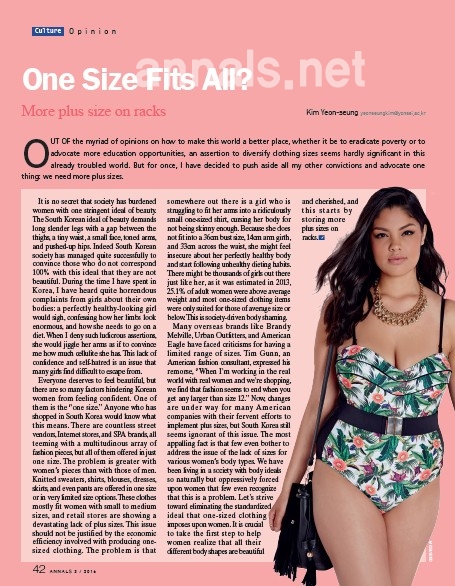More plus size outfits on the racks

OUT OF the myriad of opinions on how to make this world a better place, whether it be to eradicate poverty or to advocate for more education opportunities, an argument in favor of the need to diversify clothing sizes seems hardly significant in our troubled world. I have decided to push aside all my other convictions for now, however, and to make a case for one easily achievable change: we need more plus sizes.
It is no secret that society has burdened women with one stringent ideal of beauty. The South Korean ideal of beauty demands long slender legs with a gap between the thighs, a tiny waist, a small face, toned arms, and pushed-up hips. Indeed South Korean society has managed quite successfully to convince those who do not correspond 100% with this ideal that they are not beautiful. During the time I have spent in Korea, I have heard quite horrendous complaints from girls about their own bodies: a perfectly healthy-looking girl would sigh, confessing how her limbs look enormous, and how she needs to go on a diet. When I deny such ludicrous assertions, she would jiggle her arms as if to convince me how much cellulite she has. This lack of confidence and self-hatred is an issue that many girls find difficult to escape from.
Everyone deserves to feel beautiful, but there are so many factors hindering Korean women from feeling confident. One of them is the “one size.” Anyone who has shopped in South Korea would know what this means. There are countless street vendors, Internet stores, and SPA brands, all teeming with a multitudinous array of fashion pieces, but all of them offered in just one size. The problem is greater with women’s pieces than with those of men. Knitted sweaters, shirts, blouses, dresses, skirts, and even pants are offered in one size or in very limited size options. These clothes mostly fit women with small to medium sizes, and retail stores are showing a devastating lack of plus sizes. This issue should not be justified by the economic efficiency involved with producing one-sized clothing. The problem is that somewhere out there is a girl who is struggling to fit her arms into a ridiculously small one-sized shirt, cursing her body for not being skinny enough. Because she does not fit into a 36cm bust size, 14cm arm girth, and 33cm across the waist, she might feel insecure about her perfectly healthy body and start following unhealthy dieting habits. There might be thousands of girls out there just like her, as it was estimated in 2013, 25.1% of adult women were above average weight and most one-sized clothing items were only suited for those of average size or below. This is society-driven body shaming.
Many overseas brands like Brandy Melville, Urban Outfitters, and American Eagle have faced criticisms for having a limited range of sizes. Tim Gunn, an American fashion consultant, expressed his remorse, “When I'm working in the real world with real women and we're shopping, we find that fashion seems to end when you get any larger than size 12.” Now, changes are under way for many American companies with their fervent efforts to implement plus sizes, but South Korea still seems ignorant of this issue. The most appalling fact is that few even bother to address the issue of the lack of sizes for various women’s body types. We have been living in a society with body ideals so naturally but oppressively forced upon women that few even recognize that this is a problem. Let’s strive toward eliminating the standardized ideal that one-sized clothing imposes upon women. It is crucial to take the first step to help women realize that all their different body shapes are beautiful and cherished, and this starts by storing more plus sizes on racks.
Kim Yeon-seung
yeonseungkim@yonsei.ac.kr

